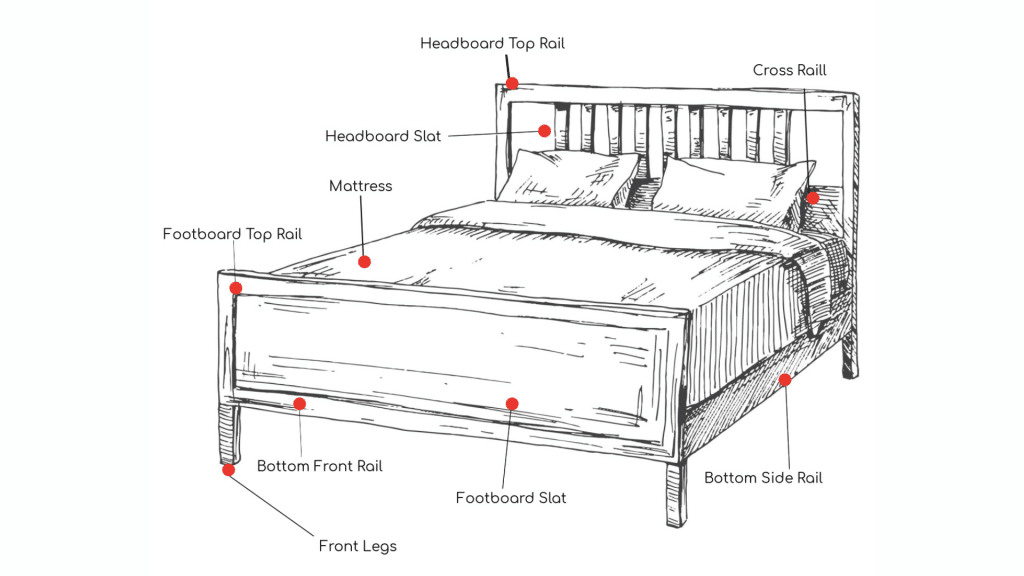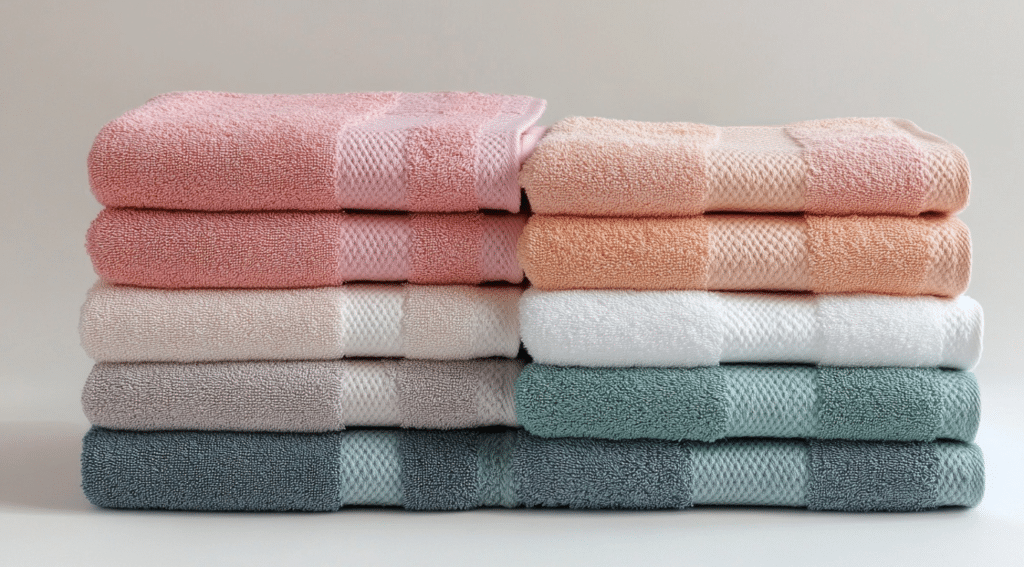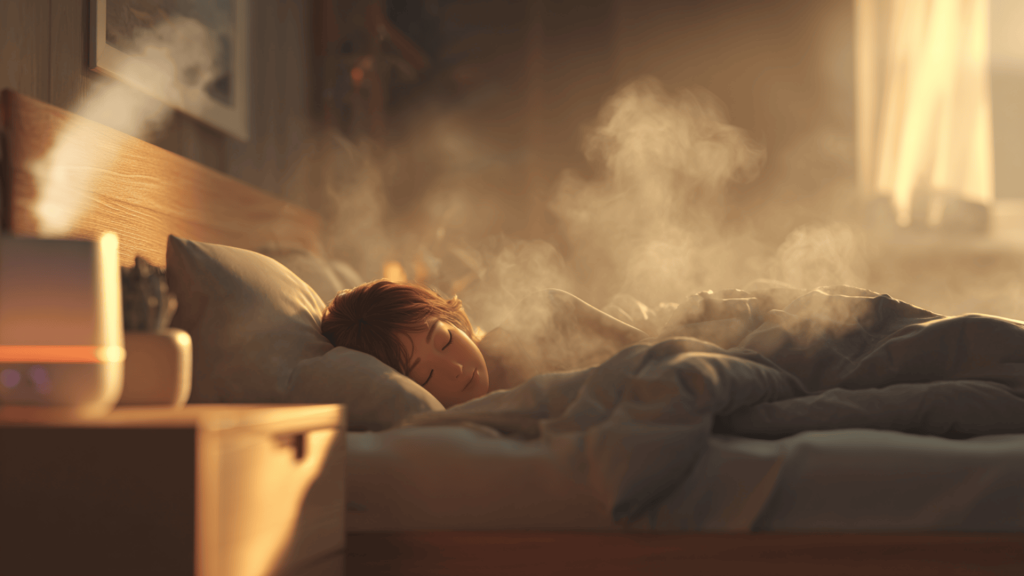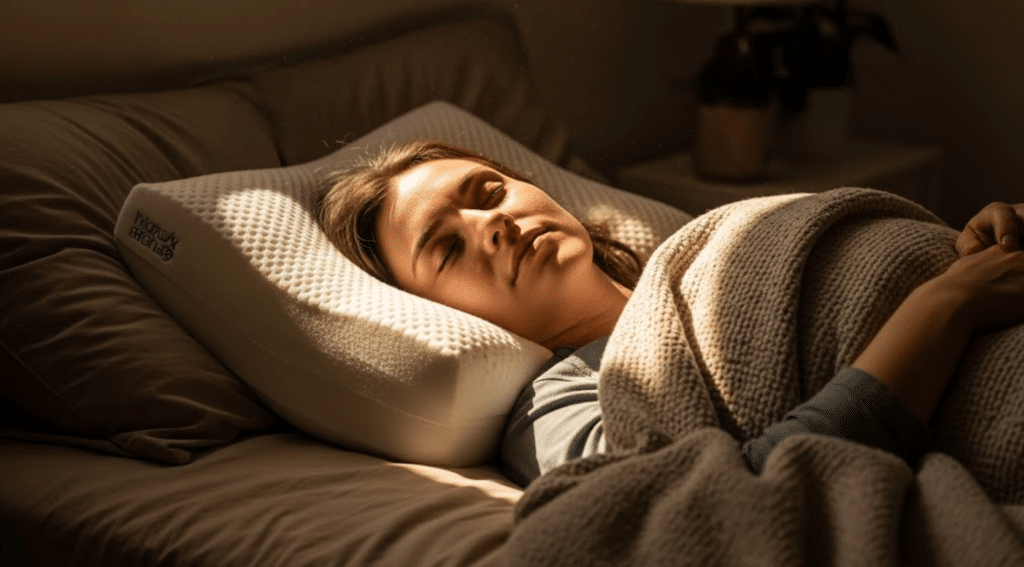You spend nearly a third of your life in bed, but most people don’t really think about the parts of a bed. I get it, frames, slats, and bases can sound like technical stuff. But knowing the basics can actually save you time, money, and stress.
In this guide, I’ll walk you through the key parts of a bed in simple terms. You’ll learn what each piece does, how they work together, and what to consider when choosing or fixing one. I’ve also included useful tips.
By the end, you’ll feel more confident about how your bed works and how to build the setup that fits your needs.
Parts of a Bed Basics: The Core Components
Before you look at headboards or fancy bedding, it’s helpful to understand the main parts that make up a bed. These core components are what give your bed structure, support, and comfort.
Let’s break down the basics so you know exactly what each part does and why it matters.
1. Mattress
The mattress is where you actually sleep. It provides comfort and support for your body. Modern mattresses come in several types, including memory foam, innerspring, latex, and hybrid models.
Memory foam mattresses conform to your body shape. Innerspring mattresses use metal coils for support.
Latex mattresses offer natural bounce and cooling. Hybrid mattresses combine foam and coils for balanced comfort.
2. Bed Frame
The bed frame holds everything together. It raises your mattress off the floor and provides structural support. Frames come in wood, metal, or upholstered materials.
A good frame prevents sagging and extends mattress life. It also creates storage space underneath and improves air circulation around the mattress.
3. Foundation
The foundation sits between your mattress and frame. It distributes weight evenly and provides additional support. Common types include box springs, platform bases, and adjustable bases.
Box springs use metal coils and fabric covering. Platform bases offer solid or slatted surfaces. Adjustable bases let you change the angle of your head and feet.
Parts of a Bed Frame
Understanding frame components helps you choose the right bed and assemble it correctly.
1. Headboard
The headboard attaches to the head of your bed. It serves both decorative and functional purposes. You can lean against it while reading or watching TV.
Headboards come in many styles, including upholstered, wood, metal, and bookcase designs. Some attach directly to the frame while others mount to the wall.
2. Footboard
The footboard sits at the foot of your bed. It’s mainly decorative, but it can prevent pillows and bedding from sliding off. Not all beds have footboards.
Low footboards work well in small rooms. High footboards make more of a design statement, but can make rooms feel smaller.
3. Side Rails
Side rails connect the headboard to the footboard. They form the main structure of your bed frame. Most rails attach with bolts or brackets.
Strong side rails prevent the bed from wobbling or separating. Look for rails made from solid wood or heavy-duty metal.
4. Center Support Rail
Beds wider than twin size need a center support rail. This beam runs down the middle of the frame from head to foot. It prevents sagging in the center of the bed.
Queen and king beds always need center support. Full beds may need it, depending on the frame design and mattress weight.
5. Slats
Slats are horizontal boards that support your mattress. They replace the need for a box spring in many platform beds. Slats can be solid wood, engineered wood, or metal.
Spaced slats allow air circulation but need gaps no wider than 3 inches. Solid slats provide more support but less airflow.
6. Legs
Legs raise the bed off the floor and provide stability. Standard height is 6 to 8 inches, but can range from 2 to 12 inches or more.
Higher beds are easier to get in and out of. Lower beds work better for children and small rooms. Some frames use center legs for extra support.
7. Cleats
Cleats are wooden strips that hold slats or platform bases in place. They attach to the inside of the side rails and prevent slats from sliding.
Metal frames often use brackets instead of cleats. Both serve the same function of keeping support elements aligned.
8. Fasteners & Brackets
These hardware pieces hold the frame together. Common types include bolts, screws, cam locks, and metal brackets.
Quality fasteners prevent wobbling and ensure long-term stability. Keep spare hardware in case pieces get lost during moves.
Bedding Components and Their Roles
Once your bed frame and mattress are in place, it’s time to focus on comfort. Bedding does more than just look nice; it affects how well you sleep.
From sheets to shams, each piece plays a part in creating a cozy, functional setup. Here’s a quick look at what each item does and how it fits into your bed.
| Component | Purpose | Notes |
|---|---|---|
| Sheets | Create a barrier between you and the mattress | Fitted (elastic corners), flat (tuck-in); cotton, microfiber, bamboo |
| Pillows & Cases | Support head/neck; protect pillow surface | Down, memory foam, synthetic fill; standard to king sizes |
| Comforter | Thick top layer for warmth | All-in-one; harder to clean |
| Duvet | Insert with removable cover | Easy to wash/change style |
| Quilt | Light top layer, often decorative | Best for warm climates or layering |
| Blankets & Throws | Add warmth or decoration | Weighted, electric, cotton, wool |
| Toppers & Protectors | Adjust comfort; shield from spills/allergens | Memory foam, latex toppers, and waterproof protectors |
| Bed Skirts & Shams | Hide under-bed space; add visual polish | Skirts cover the base; shams are decorative pillow covers |
Choosing the Right Bed Setup
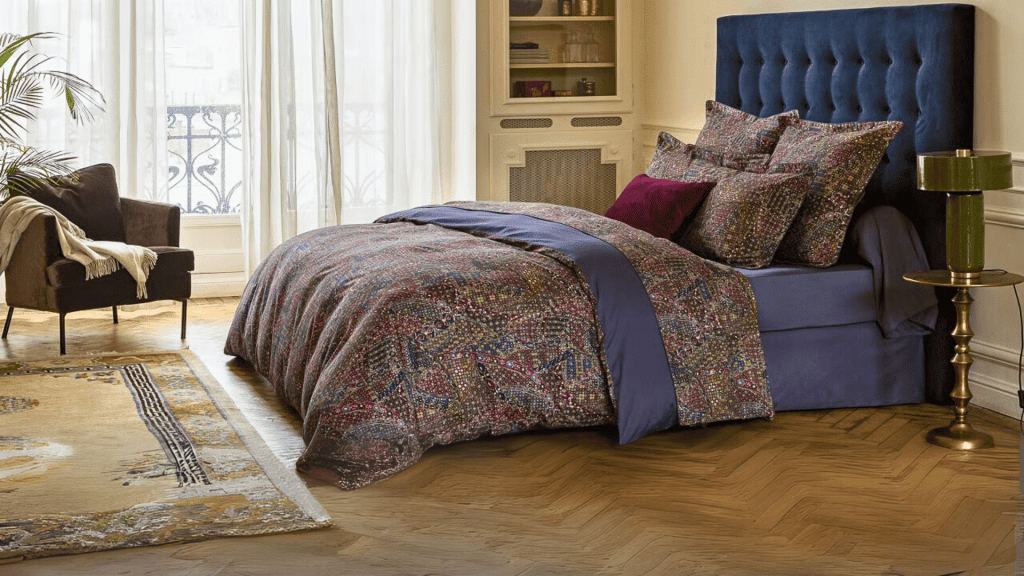
The best bed setup depends on your space, comfort needs, and sleep style. Here’s how to choose what works for you.
Based on Mattress Type
Memory foam mattresses work well on solid platforms or closely spaced slats. Innerspring mattresses can use box springs or platforms. Latex mattresses need good air circulation.
Hybrid mattresses are flexible and work with most foundation types. Always check your mattress warranty requirements for foundation specifications.
Based on Room Size
Small rooms benefit from platform beds with built-in storage. Low-profile frames make ceilings appear higher. Beds without footboards create more open floor space.
Large rooms can handle bigger frames with headboards and footboards. Higher beds work well in spacious rooms and provide more under-bed storage.
For Different Sleep Styles
Side sleepers often prefer softer mattresses with pressure relief. Back sleepers need good spinal support from their mattress and foundation. Stomach sleepers do best with firmer surfaces.
Couples may need motion isolation from their mattress and a sturdy frame that doesn’t squeak. Hot sleepers benefit from breathable foundations and cooling bedding.
Global Bed Styles and Innovations
Different parts of the world use creative bed setups based on space and lifestyle needs. Here are a few:
- Japanese Futons: Thin mattresses placed on tatami mats; easy to fold and store during the day.
- Murphy Beds: Fold into the wall to save floor space; ideal for small apartments or multipurpose rooms.
- Adjustable Beds: Allow changes in head and foot positions for comfort or medical support.
- Smart Beds: Track sleep, adjust firmness, and regulate temperature automatically.
- Modular Systems: Beds that can be rearranged or converted into seating for flexible use.
These setups show that beds don’t have to follow one standard.
If you’re short on space or looking for added comfort, borrowing ideas from other cultures or modern tech can help you create a bed that fits your life.
Glossary of Bed Terms or Types
These definitions help you understand bed-related language when shopping or reading instructions.
- Platform: A solid or slatted base that supports a mattress without a box spring.
- Cleat: A wooden strip attached to side rails that holds slats in place.
- Duvet: A soft flat bag filled with down or synthetic material, used inside a removable cover.
- Slats: Horizontal wooden or metal strips that support a mattress across a bed frame.
- Coverlet: A lightweight bedspread that doesn’t reach the floor, often used for decoration.
- Box Spring: A supportive base made of springs in a wooden frame, covered with fabric.
- Foundation: Any base that supports a mattress, including box springs, platforms, and adjustable bases.
Wrapping Up
Now that you know the key parts of a bed, you can look at your own setup with fresh eyes. I’ve walked you through what each piece does and how it all comes together to support the way you sleep.
Understanding these details helps you make better choices if you’re replacing a worn-out part, adjusting your frame, or just figuring out what’s missing.
It’s your bed, and it should work for your comfort, your space, and your routine.
If you’re thinking about making changes or need some inspiration, check out some of my other blogs. You might find ideas to help you create a sleep space that feels even more like yours.

